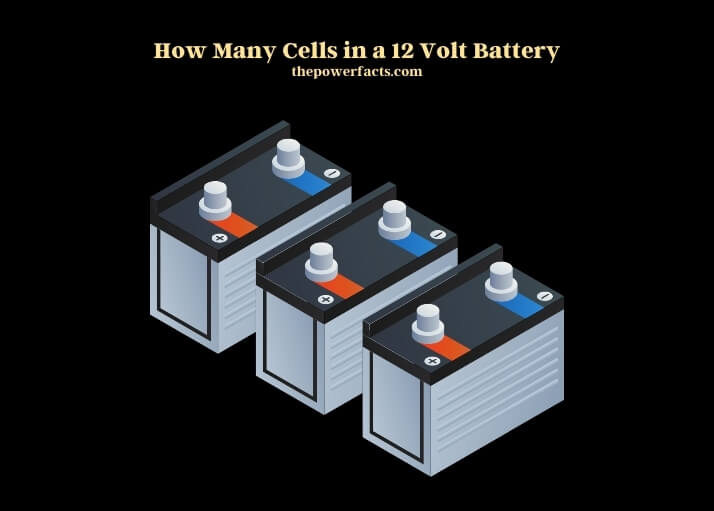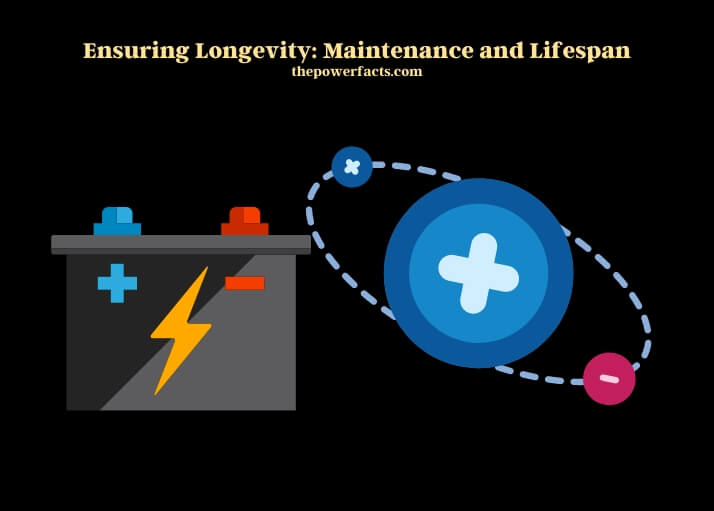A 12-volt battery typically contains six cells. Each cell contributes approximately 2 volts to achieve the total voltage.
The structure and performance of a 12-volt battery are crucial for a wide range of applications, from automotive to renewable energy systems. The cells within these batteries, usually lead-acid or lithium-ion, are arranged in series to cumulatively provide the necessary voltage.
This arrangement is fundamental to the battery’s operation, influencing not only its voltage but also its capacity and overall performance. The capacity of a battery, measured in ampere-hours (Ah), indicates how much charge the battery can store and deliver, impacting how long it can power devices or vehicles before needing a recharge.

Temperature significantly affects battery performance, with extreme conditions leading to reduced efficiency and lifespan. Proper charging and maintenance are essential for extending the life of the battery, preventing issues such as overcharging or deep discharge, which can damage the cells.
Innovations in battery technology continue to improve energy density, efficiency, and environmental sustainability, making the understanding of these components more important than ever for users and manufacturers alike. As technology advances, the role of 12-volt batteries in powering our world becomes increasingly vital, highlighting the importance of optimizing their design and use for future applications.
Inside a 12 Volt Battery: Cells and Structure
A 12-volt battery, a staple in automotive and renewable energy applications, operates on a simple yet fascinating principle. Typically, it consists of six cells, each generating approximately 2 volts, cumulatively achieving the 12 volts for which these batteries are known. The cells, connected in series, work together to power everything from vehicles to solar panels. This synergy is not just about voltage; it’s a delicate balance of chemistry, physics, and engineering.
Each cell’s chemistry, whether lead-acid in traditional car batteries or lithium-ion in modern applications, dictates its voltage output and capacity. The lead-acid variant, for instance, relies on a chemical reaction between lead dioxide, sponge lead, and sulfuric acid to produce electricity. In contrast, lithium-ion cells, found in portable electronics and electric vehicles, operate on the movement of lithium ions between anode and cathode through an electrolyte.
| Battery Type | Cell Count | Voltage per Cell | Total Voltage |
| Lead-Acid | 6 | 2V | 12V |
| Lithium-Ion | 6 | 2V | 12V |
| Nickel-Metal Hydride | 10 | 1.2V | 12V |
This table illustrates the diversity in cell structure across different battery technologies, each with its unique advantages and applications.
Powering Performance: Cell Count and Capacity
The capacity of a 12-volt battery, measured in ampere-hours (Ah), is a direct reflection of its cell composition. More cells can mean higher capacity, but the real story is in how these cells are arranged. In series, they boost voltage; in parallel, they increase capacity. This arrangement allows for flexibility in battery design, catering to specific needs like higher power output or longer duration between charges.
The relationship between cell count and battery capacity is not linear but rather dependent on the efficiency and chemistry of the cells involved. For instance, a battery designed for high-performance applications may use advanced lithium-ion cells with higher energy density, allowing for greater capacity within the same 12-volt framework.
| Battery Type | Capacity Range (Ah) |
| Automotive Lead-Acid | 40-110 Ah |
| Deep Cycle Lead-Acid | 50-200 Ah |
| Lithium-Ion | 100-300 Ah |
This table showcases the capacity variations, highlighting how advancements in cell technology can significantly impact performance.
Ensuring Longevity: Maintenance and Lifespan
Maintaining the health of a 12-volt battery extends beyond simple charging. It involves understanding the nuances of each cell’s needs, from the optimal charge cycle to temperature control.
For lead-acid batteries, regular checks on electrolyte levels and avoiding deep discharges are key. Lithium-ion cells, meanwhile, benefit from staying within specific voltage ranges during charging and discharging to prevent premature aging.

The lifespan of a battery’s cells is a testament to the care and usage they receive. On average, a lead-acid battery can last 3-5 years, while lithium-ion variants push this boundary further, offering up to 5-7 years under optimal conditions. This longevity is crucial for applications where reliability and performance over time are paramount.
Charting the Future: Battery Cell Innovations
The landscape of 12-volt battery technology is ever-evolving, with research and development pushing the boundaries of what’s possible. Innovations in cell chemistry, such as solid-state batteries, promise higher energy densities, improved safety, and longer lifespans. These advancements are not just technical achievements; they represent a shift towards more sustainable and efficient energy storage solutions.
Emerging trends focus on reducing the environmental impact of battery production and disposal, enhancing the recyclability of battery materials, and improving the overall efficiency of energy storage. As these technologies mature, the potential applications for 12-volt batteries expand, from more powerful electric vehicles to more resilient renewable energy storage systems.
Comparative Insights: 12 Volt Battery Variants
Diving into the specifics of different 12-volt battery types reveals a landscape rich in diversity and specialization. Lead-acid batteries, with their robustness and cost-effectiveness, remain the go-to choice for automotive starters. Lithium-ion batteries, on the other hand, shine in applications requiring high energy density and efficiency, such as portable electronics and electric vehicles.
| Battery Type | Energy Density (Wh/kg) | Recharge Cycles |
| Lead-Acid | 30-40 | 300-500 |
| Lithium-Ion | 150-200 | 1000-2000 |
| Nickel-Metal Hydride | 60-120 | 500-1000 |
This table contrasts the key performance metrics, underscoring the trade-offs between energy density, longevity, and cost across battery types.
Frequently Asked Questions (FAQs)
Can Temperature Affect Battery Cell Performance?
Temperature plays a significant role in the performance of the cells within a 12-volt battery. Extreme temperatures, both hot and cold, can adversely affect the battery’s ability to hold and deliver charge. In cold conditions, the chemical reaction within the cells is slowed down, reducing the battery’s efficiency and making it harder to start engines in vehicles.
Conversely, high temperatures can accelerate the chemical reaction, potentially leading to overcharging, increased evaporation of the electrolyte, and faster degradation of the battery components. Consistently operating a battery outside of its recommended temperature range can significantly shorten its lifespan and decrease its overall performance.
Impact of Charging Methods on Cell Longevity
The method and manner in which a 12-volt battery is charged can greatly influence the longevity of its cells. Overcharging or undercharging can lead to sulfation, where lead sulfate crystals form on the battery plates, which can permanently reduce the battery’s capacity and lifespan.
Smart chargers that adjust the charge rate based on the battery’s condition can help mitigate these risks by ensuring the battery is charged optimally. Maintaining a proper charging routine prevents the cells from being stressed unnecessarily, thereby extending the battery’s useful life.
Does the Size of a Battery Affect Its Cell Count?
The size of a 12-volt battery does not directly affect its cell count since the voltage is determined by the cells connected in series, each contributing a specific voltage to reach the total of 12 volts.
What varies with size, however, is the capacity (measured in ampere-hours) and the physical dimensions of the battery, which can accommodate larger or more efficient cells. Larger batteries may have cells with greater capacity, providing longer usage times between charges but will still maintain the standard six cells to achieve 12 volts.
Role of Cell Chemistry in Battery Selection
The chemistry of the cells within a 12-volt battery is crucial for determining its application, performance characteristics, and lifecycle. Lead-acid batteries are commonly used in vehicles for their high surge currents, making them ideal for starting engines.
Lithium-ion batteries, with their higher energy density and longer lifespans, are preferred in portable electronics and electric vehicles. The choice of cell chemistry affects the battery’s cost, maintenance requirements, environmental impact, and safety features, making it a key consideration in battery selection.
How Do Parallel Connections Influence Battery Cells?
Connecting battery cells in parallel within a 12-volt system can increase the overall capacity (ampere-hours) without changing the voltage. This arrangement allows each cell to share the load, potentially extending the battery’s lifespan by reducing the strain on individual cells.
It’s essential to ensure that the cells are identical in type and state of charge to prevent imbalances, which can lead to cells discharging into each other, causing overheating and reduced efficiency. Proper management and monitoring of parallel connections are crucial for maintaining battery health.
The Effect of Discharge Rates on Cell Health
The rate at which a 12-volt battery is discharged can significantly impact the health and longevity of its cells. High discharge rates can cause heat buildup, leading to accelerated degradation of the battery components. This stress can result in a shorter lifespan and diminished capacity. Conversely, slow, controlled discharges are less taxing on the cells, promoting longer life and sustained performance.
Managing the discharge rate according to the battery’s specifications and the application’s demands is essential for optimizing battery health and efficiency.
Summary
The journey through the intricacies of 12-volt batteries unveils a world where chemistry, physics, and engineering converge to power our lives. From the fundamental cell structure to the cutting-edge innovations shaping the future, each aspect of a battery’s design and function plays a critical role in its performance and application. As technology advances, the potential of these batteries expands, promising a future powered by more efficient, durable, and environmentally friendly energy storage solutions.